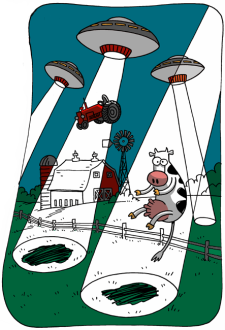Particle sorting with a miniature light railway
![]() Lasers which can control the movement of particles are still confined to the microscopic world, but if you have an over-reactive imagination, you might wonder just what the limits are on the size of bodies which these devices can control and whether science fiction's tractor beams are becoming a reality. Today's technology may not be capable of producing force fields that lock on to starships and guide them in to land, but the size of particles which can be manipulated by light are getting larger.
Lasers which can control the movement of particles are still confined to the microscopic world, but if you have an over-reactive imagination, you might wonder just what the limits are on the size of bodies which these devices can control and whether science fiction's tractor beams are becoming a reality. Today's technology may not be capable of producing force fields that lock on to starships and guide them in to land, but the size of particles which can be manipulated by light are getting larger.

Trapping particles up to a few microns (thousandths of a millimetre) in diameter using lasers, is well established technology performed by instruments called optical tweezers. They are capable of controlling the movement of individual particles by the relative motion of the laser beam, and find applications in cell biology and microfluidics. They typically use a focused laser spot to produce a trap in which a single particle is confined in the central region where the electric field is strongest. Now researchers in the US have devised a way of using the linear beam profile of diode laser bars to trap particles within its length†.
Diode laser bars are semiconductor lasers whose output beam profiles are not a classic spot shape, but which form discrete lines. To create a linear optical trap, the researchers focused the laser so that its linear beam profile was preserved. This trap was formed within a glass capillary tube containing water, into which polystyrene particles of known size were dropped. With the aid of a camera they were able to see what influence the laser had on different sized particles.
In accordance with their mathematical models, sizes up to 100 μm were easily trapped, but the 200 μm diameter particles were not. Particles could be trapped anywhere along the length of the trap and yet were free to move within it. By rotating the focused beam so that it was parallel with the vertical flow of particles falling under the influence of gravity, trapped particles would settle to the bottom of the trap line.
The larger particles were not trapped but they could still be deflected. By projecting the laser line at an angle from the vertical, they showed how the 200 μm particles could be deflected from their natural downwards path by the trap. This could be an effective sorting mechanism whereby smaller particles experience a greater deflection than those which are larger. The paper's authors suggest that a commercial device working on these principles might operate at higher speeds than any existing products. Their models also suggest that it may be possible to deflect particles of up to 500 μm diameter.
They're not locking on to enemy starships or plucking unsuspecting individuals from remote urban roads by means of light beams sent down from the skies, but what these scientists have demonstrated is yet another way in which lasers can aid in the non-mechanical sorting of tiny particles. Perhaps its more like a miniature light railway, which actually does use light to convey vehicles along its tracks.
† Reference: Applegate Jr., R., Marr, D., Squier, J., & Graves, S. (2009). Particle size limits when using optical trapping and deflection of particles for sorting using diode laser bars Optics Express, 17 (19) DOI: 10.1364/OE.17.016731
‡ Image: By Greg Williams (Creative Commons Attribution).
 Articles published in the Optical Future's blog are licensed under a Creative Commons Attribution-Non-Commercial 2.5 Canada License.
Articles published in the Optical Future's blog are licensed under a Creative Commons Attribution-Non-Commercial 2.5 Canada License.
